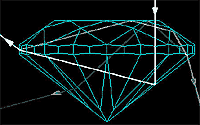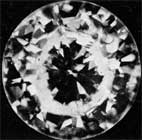Learn: Diamonds > Fish-Eye
Introduction
Transparency
Clarity
Twinning
Myth
Artificial Intelligence & Clarity Grading
Eye Clean
Clarity Characteristics
Flaws & Cracks
WHat is a fish eye in a diamond?
Fish-eyes are more apparent if the pavilion is shallow 39.5°, the table is large; the girdle is thick and not polished. Combinations of these factors worsen the effect.
Holloway Cut Adviser test takes fish-eye into account. They occur between the following pavilion depths and table sizes:
41-degree pavilion and 72.2% table
39-degree pavilion and 58.4% table
Diamonds with these proportions show fish-eyes that require no tilt to see them. If the table gets 1% bigger you see a 1% more fish-eye.
We downgrade these flaws in value, a bit like an inclusion because that is what they look like.
A Holloway Cut Adviser test and report will give you a ” do not buy this diamond under any circumstances as it is a fish-eye ” comment if it is very bad.
A small amount of tilt to see flaws is acceptable because these diamonds have a very good spread and look very big for the money. If the fish-eye can only be seen with 5 degrees or more tilt then we consider the diamond to be ideal.

Fish-eye cut ray path

H&Fish-eye examples H&Diamond Grading ABC H&V Pagel-Theisen

